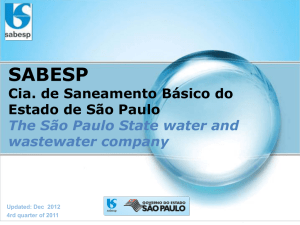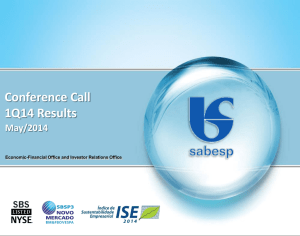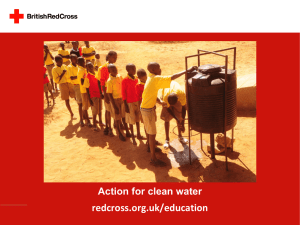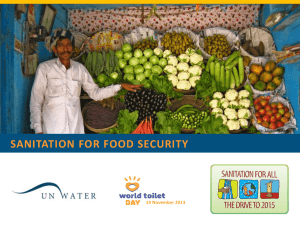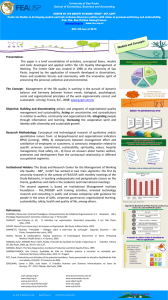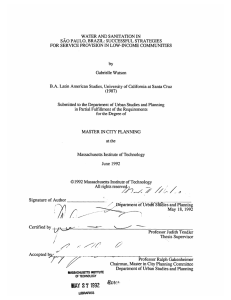Water losses reduction program
advertisement
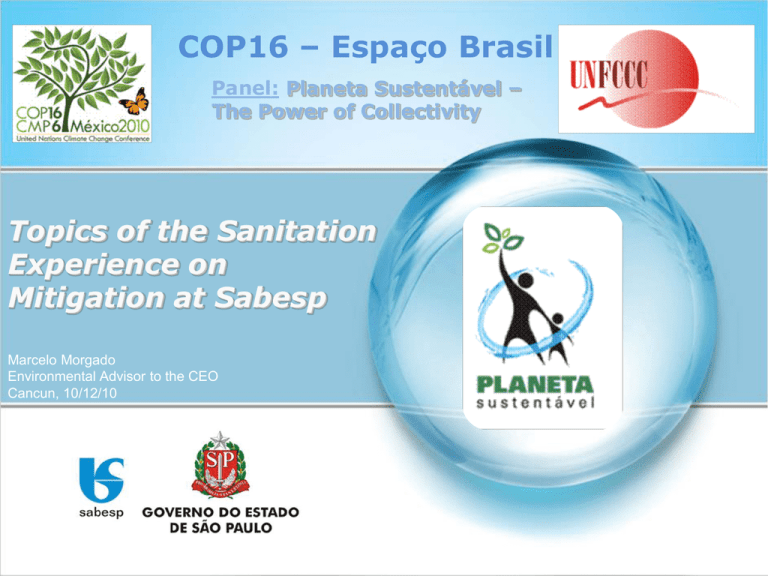
COP16 – Espaço Brasil Panel: Planeta Sustentável – The Power of Collectivity Topics of the Sanitation Experience on Mitigation at Sabesp Marcelo Morgado Environmental Advisor to the CEO Cancun, 10/12/10 Topics Sabesp figures; Sanitation & Climate Change; Sabesp pioneering in reporting and producing a carbon inventory; Sabesp efforts for mitigation: Water losses reduction program; Adoption of alternative energy sources (dams falls, biogas and solar heating); Partnerships for reasearch and innovation with universities and leading companies; Fleet renovation with flex-fuel cars. Sabesp One of the largest water and sewage service providers in the world… Total Internacional 115.0 108.4 63.1 26.0 Veolia Suez RWE AGBAR 25.6 Sabesp 23.8 United Utilities 15.7 ACEA 14.5 Severn Trent Source: Pinsent Masons – Water Yearbook – 2006-2007 (includes 3,3 million clients in municipalities currently served on a wholesale basis) 13.2 SAUR Strong corporate governance... Mixed capital company Listed on the “Novo Mercado” and NYSE, leading to high corporate governance standards (means SOX, SEC, CVM, SP State Control Bodies etc.) 100% common shares NYSE 25.7% Bovespa 24.0% State of São Paulo Government 50.3% Expansion of sanitation services major challenge in Brazil… Water service Sewage service < 40% < 10% 40,1 a 60% 10,1 a 20% 60,1 a 80% 20,1 a 40% 80,1 a 90% 40,1 a 70% > 90% > 70% Source: SNIS, 2007 is a Sanitation index regions (%)… Region Water in the Brazilian Sewage collection Sewage treatment (%) North 62.7 6.1 8.4 Northeast 92.5 26.4 31.9 South-east 95.7 69.6 33.7 South 99.2 35.2 28.2 Mid-west 98. 0 45.9 42.8 Brazil 93.1 48.3 32.2 Source: SNIS Capex plan for 2009 – 2013… Sanitation & Climate Change Global Warming Impacts on the Business Directly: • Unstable raining cycles and droughts, more evaporation at dams, more consumption due to hot weather, more algi blooms, eventual spread of POPs/contaminants at watertables. Undirectly: • Investments / expenses for accomplishing to S. Paulo State challeging targets (20% reduction till 2025 – base line 2005); • Damage to installations (WTP in Franca and Campo Limpo were flooded in 2009). Key Role of the Sanitation Sector • an electro intensive sector due to the needs in aeration at the wastewater treatment and for pumping water and sewage (more for water, that is distributed pressurized, than for sewage, that is mostly collected by gravity) – Sabesp is the major electricity consumer at São Paulo state, responsible for 1.82%; • the size at the economy: at Brazil, sanitation is responsible for 2.0% of the total GHG emissions at 2005 (2.0% at 1990). In absolute figures in 2005: 18107 Gg de CH4 e 639 Gg de CO2 . For comparison: gargage emissions mean 7.8% and industrial effluents 3.3%, (Source: Brazilian 2nd Nat. Com. to UNFCC – 2010). At the S. Paulo State Inventory the sanitation means 1.6% (26.5% of "Residues & Effluents" that means 6% of the GHGs issued at the state). The industrial effluents contribution is 1.1% and the industrial incinerators, 0.01%; Positive inertia trend of the sanitation The sanitation potentially reduces emissions as universalization comes through, due to several reasons: 1) less methane generation at septic ditches and rivers beds (anaerobic degradation of settled solids from sewage discharges); 2) activated sludge treatment is the leading option for treatment. It is aerobic (generating mostly CO2) vs. anaerobic / facultative ponds (generating methane); 3) biogas from biodigesters to be burnt in general in flares or CHP plants abating methane. Obs: the inventories do not show this trend as compile emissions from existing plants. Opportunities for conciliating “Ecology and Economy” • reducing water losses (leakages) and at the same time: 1) consuming less electricity (for pumping and treating); 2) avoiding investments for bringing raw water from even more far, with extra pumping costs; • promoting ciliary reforestation at rivers, lakes and dams and at the same time: 1) keeping the quality of the water natural resources, meaning less treating chemicals; 2) preventing erosion and so floods, flow reduction and poor quality by silting; • stimulating / inducing water rational use among consumers and at the same time: 1) creating a new service for the larger customers; 2) avoiding investments in developing new resources; • producing energy from dams and discharges level differences (hydropower with no new flooded areas); • burning WWT plants sludge and biogas and generating electricity and steam (heat for termophilic digestion meaning more methane and less sludge). Conclusions: Positive inertia on GHGs of the sanitation universalization, besides social & environmental benefits. Sabesp carbon inventory 1st Inventory of a sanitation company in South America In 2008, Sabesp published its 1st Carbon Inventory pointing out 1.719.159 tonnes of CO2-e, ref. year 2007. The main source of direct emissions is the collection and treatment of sewage, corresponding to 93.2%. The 2nd most important are undirect emissions from electricity consumption: 3.7%. Note: the evaluation has followed the GHG Protocols. EMISSION TYPE Direct Undirect Total ACTIVITY TONNES OF CO2e Sewage treatment (treated and non treated) 1,590,268 Owned fleet of vehicles 22,106 Nautic fleet (surveillance of dams) 4 Generators and other machines 23,222 Electricity 62,928 Leased fleet 20,365 Air transport of employees 266 - 1,719,159 CDP reporting since 2006 ... Decision made for starting CDP Supply chain in 2011 (200 key companies will be selected (ABC curve) and involved); 2.6 billion without access to sanitation; Perspective to adhere to the new “CDP Water” (survey on water footprint published at the Water Rational Use Handbook for Commerce Firms) in partnership with Fecomercio (Federation of Commerce in S. Paulo State). Sabesp efforts for mitigation Sabesp supported at COP15 more challenging goals Our CEO has subscribed the UN Global Pact “Seal the Deal Campaign” (148 messages from CEOs - 12 from Brazilian companies) Sabesp is the Brazilian leading sanitation company, proud to be in the Global Pact. The global warming will impact our business, affecting the rain cycle. So we are already taking actions for saving energy, reducing water losses, producing from renewables like biogas and hydropower at dams and sponsoring ciliary forest projects. Sabesp follows São Paulo State Policy on Climate Change, that express its commitment to overcome this challenge. We aim to do more and hope the world leaders agree a powerful compromise for dealing with this threat for the mankind and other species at Earth, our common home. Gesner Oliveira Sabesp CEO Sabesp sponsors partnerships for awareness and projects on the GW issue An initiative for divulging sustainability concepts and good practices by a portfolio of 36 magazines and an exclusive site organized by Abril - the leading publishers group in South America. Promotion of meetings (Ex: Pavan Sukhdev – UNEP, Nobel prizes Al Gore and Muhammed Yunus; awareness exhibitions like "Planet at Ibirapuera Park" in São Paulo, manuals promoting citizens good environmental attitudes etc.). www.planetasustentavel.com.br Sponsoring partners Through the partnership with Fapesp, Sabesp will take a major leap in research, technology and innovation… (R$ millions) One of the 7 research lines is projects for energy efficience Sabesp FAPESP 6.00 6.00 6.00 10.12 11.12 11.12 11.12 2011 2012 2013 2014 5.00 2.00 3.42 3.50 4.78 2007 2008 2009 7.12 2010 FAPESP is one of the main institutions to develop scientific and technological research in Brazil. It has an annual budget of R$ 400 millions. FAPESP SABESP Cooperation with leading tecnology companies… Sabesp and GE signed a technical cooperation agreement for partnerships in projects in water and sewage treatment (ultrafiltration membranes, MBR), effluent reuse and energy generation in Brazil and abroad. 50% of the water supply to São Paulo Metropolitana Region (20 millions inhab.) comes from very far away ... CAIEIRAS 22 1 Million Trees at Cantareira “The water doesn’drop from trees, but without trees, there is no water” A partnership with NGOs (Inst. Ipê and The Nature Conservancy) 552,000 saplings from 60 different species planted in 2009. The project is supported by local municpalities and the SP Environmental Affairs Secretary. It involves local people awareness and a restoring workers cooperative was created. Project “1 Million Trees at Cantareira” Expected benefits for ecoturism Jacareí dam (Joanópolis) – Environmental Park of Mangue Seco Muncipality of Joanópolis – 40 ha Cachoera dam (Piracaia) TNC (The Nature Conservancy) – 350 ha Atibainha dam (Nazaré Paulista) Instituto Ipê – 35 ha (enlarged in 8 ha) “552.000 saplings planted till Dec/09” Planting trees: Compromisse with the future ... – Produçtion of till 80 natives especies; – Planting of 140K saplings from 2003 to 2006; – Planting of 800K saplings from 2007 to 2009 (in 2009 plantadas 547,750 at Cantareira and 130K from agreements (TACs e TCRAs) with local Public attorneys – Saplings nurseries: • Jaguari (Vargem): 100,000 saplings / year - cartridges 2L/ano + 400,000 saplings / year - tubettes • Morro Grande (Cotia): 60,000 saplings / year • Jales: 5,000 saplings / year Sabesp sponsors partnerships for awareness and projects on the GW issue An NGO & Technology firm aims to develop a sapling aerial planting skeme by planes “bombing” devasted areas with seedlings inside biodegradable cartridges. Reducing water losses Losses reduction in percentage figures Sabesp water loss: 26%. Circa the 1/3 comes from non payed water and frauds, most of it at slums in S. Paulo Metropolitan Region. Brazil’s water losses: aprox. 40 % of the WWT and wells output. Source: SNIS-2006 Building small hydro plants using the falls of existing dams overflow Schedule and deadlines : Contract subscription : - December/09; Installation License : - January/10 - June/11 (18 months); Works: - July/11 - October/12 (16 months); Operation/Trade: - November/12 - October/30 (grant's end– ANEEL). Energy potence: Guaraú intake: 4.2 kW Cascata: 2.8 kW ETA Guaraú dissipation basin Small savings are important and can be replicated Solar collectors provide hot water (1.8m³/h @ 55oC) for washing the thickening equipment and centrifuges that dewater the sludge (12t/day) – saving 120kWh/month (no chemicals due to the higher temperature) Taubaté-Tremembé WWT plant Cover of sewage stabilization ponds Cover of anaerobic ponds for retaining and burning methane at the biogas in flares or at small generators for local electricity consumption. Partnership: Sansuy, provider of the PVC geomembranes and installation. Under development flat coverages. ETE Guzolândia Water reuse projects New Markets… Aquapolo Ambiental Project The largest project of wastewater reuse in Brazil and one of the largest in the world ... EXPAND the use of water reuse in the INDUSTRY ENABLE the water supply needed to the EXPANSION of capacity of the Pólo Petroquímico de Capuava Supply capacity: 1.000 l/s Enough to supply a city of 600K inhab. Total investment: R$252 million Renewing the vehicles fleet & Ethanol use Fleet renewed with flex-fuel cars and optimization In 2009, 4,800 light and heavy vehicles from the service fleet were substituted by flex-fuel ones and alcohol feeding was made compulsory. The conversion brought 1.2 million liters savings per year, due to better performing engines and racionalization of the number of cars (1,605 owned vehicles decommissioned to 1,442 leased). The maintenance was streamlined with contract clauses related with performance. The share of alcohol at the total fuel purchased has increased from 17 to 28% (Obs: in Brazil the diesel contains 5% of biodiesel). The overall effect was an annual reduction of 1,200 t of CO2-e emissions. Recognition One of the 22 “Leading Companies in Climate Change Policies” Awarded by “Época” magazine (400,000 readers). Globo Editors Think about GW in daily habits – reduce the gap between speaking and attitude Each 1 PET bottle 1 liter of mineral water requires 200 ml of oil for being made. The flight from Fidj to San Francisco of mineral water means 0.85kg of fuel per bottle. The world consumes 180 billion liters of mineral water per year. This businesss issues 60K tonnes yearly only in Australia = 13,000 cars. Drink tap water (of course if it is from a good supplier) Thank you! Marcelo Morgado Environmental Advisor to the CEO mmorgado@sabesp.com.br www.sabesp.com.br – twitter: @ciasabesp 55-11-33888954
